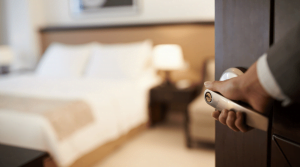What Is a Pied-à-Terre in NYC Real Estate?
February 14, 2025 by Georges Benoliel
Go Back To Previous Page
 A “Pied-à-Terre” is a French phrase that translates to “a foot on the ground.” We refer to a crash pad in the city, occasionally used by the owner. A Pied-à-Terre is a smaller apartment for weekend stays or a couple of nights during the week. A Pied-a-Terre in NYC is not commonly considered a vacation home; instead, it is more of a crash pad for an owner to feel at home while away from their primary residence. Buying a Pied-a-Terre in NYC: Is it worth it? What are the benefits of purchasing a pied-à-Terre in NYC? There are several benefits and some disadvantages of owning a Pied-a-Terre, which we will briefly discuss below.
A “Pied-à-Terre” is a French phrase that translates to “a foot on the ground.” We refer to a crash pad in the city, occasionally used by the owner. A Pied-à-Terre is a smaller apartment for weekend stays or a couple of nights during the week. A Pied-a-Terre in NYC is not commonly considered a vacation home; instead, it is more of a crash pad for an owner to feel at home while away from their primary residence. Buying a Pied-a-Terre in NYC: Is it worth it? What are the benefits of purchasing a pied-à-Terre in NYC? There are several benefits and some disadvantages of owning a Pied-a-Terre, which we will briefly discuss below.
Introduction to Buying a Pied-a-Terre in NYC
Living in the heart of New York City is a dream for many: the famed city, the incredible food, the celebrities around every corner. Having a home (or secondary home) in NYC is a dream for many people, and such opportunities are pied-à-Terre purchases.
(or secondary home) in NYC is a dream for many people, and such opportunities are pied-à-Terre purchases.
We will go over the pied-à-Terre meaning of ” pied-à-Terre. This guide will teach you everything you want to know about them.
A Pied a Terre in NYC can describe any property type, including a condo, co-op apartment, or townhouse. Co-op apartments are generally the least expensive option; however, not all co-op apartments permit usage. Here is your 2022 guide to buying a Pied-à-Terre in NYC.
What does Pied-à-Terre mean in NYC real estate?
A French term translates to English as “a foot on the ground” that doesn’t explain what a pied-à-Terre is in and of itself. But let’s think about that: a foot on the ground is just somewhere to land for a short time.
We will explain, in essence, what a pied-à-Terre is in NYC. It’s a fancy apartment in NYC whose owners only use it for short periods, such as a weekend getaway or a second home for occasional visits. It’s a vacation home, and the owners do not intend to use the unit as a primary residence.
weekend getaway or a second home for occasional visits. It’s a vacation home, and the owners do not intend to use the unit as a primary residence.
Although they don’t necessarily have to cost millions of dollars, having a second residence in the middle of the city will not be cheap. We’ll get into what they cost a bit later. Let’s discuss pros and cons.
Benefits of Purchasing a Pied-a-Terre
So why would anyone want to buy one in the first place? Let’s examine four main reasons people purchase these properties in NYC. Also, focus on air rights.
Secondary residence in the heart of NYC.
A second home in the heart of NYC affords pied-à-Terre owners a few benefits. They might buy it to have somewhere to go for a weekend getaway or vacation. Or maybe be closer to their kids attending the area.
Cuts down on the commute for a job in the city.
Anyone who works in downtown New York City knows that traffic is abysmal. So, for anyone living outside the city’s downtown limits, having a property near their job can be a great place to stay during the week.
I was surrounded by celebrities and entertainment year-round.
Besides living closer to family or shortening your commute, having a second home puts you in the middle of one of the world’s entertainment capitals. You’ll surround yourself with celebrities, athletes, and world-class entertainment.
NYC is a city that never sleeps and doesn’t look to slow down anytime soon. That said, property values will continue increasing in downtown NYC. So, if you spend the money on an apartment today, it could be worth significantly more later. Investment tax benefits and deductions, such as depreciation with owning an apartment in the New York City real estate market.
It’s a real estate investment property in one of the best housing markets in the world. If your building allows it, you can use it as a rental property by leasing it to renters.
The Downside of Buying a Pied-a-Terre in NYC.
- Closing costs, a mansion, and other fees surrounding purchasing your part-time apartment in the city get costly.

- The financial burden of paying monthly maintenance fees all year, even if you hardly use your apartment or it’s vacant for most of the year.
- Depending on your building’s rules, you may be unable to rent it out.
- Tax rules surrounding Pieds-a-Terre may change at any time, and this has been a topic in New York City real estate for quite some time. In 2021, state legislatures considered implementing a tax to help the state budget.
How Much Should You Plan to Spend Each Month?
Owners intend to use a Pied-à-Terre occasionally. Generally, a buyer should spend under a thousand a month on maintenance costs and mortgage payments.
Is a Pied-à-Terre Expensive in New York City real estate?
Pied-à-Terre apartments in NYC are costly. This is true for a secondary residence where you will not spend much time. Most people who make a standard income and live a relatively everyday life will not be able to afford one.
Most people who make a standard income and live a relatively everyday life will not be able to afford one.
Prices can range all over the place for apartments in NYC. We’ll try to give you an estimate of what you can expect to pay. The cheapest high-quality properties in NYC will run about $300,000 – $500,000 or more. From there, the price rises and reaches the millions rather quickly.
Celebrities and the 1%’ers can spend over $100 million on the city’s fanciest penthouse apartments. So they can certainly cost a pretty penny. So what about the pied à terre taxes involved?
Can You Finance a Pied-à-Terre in New York City?
Yes, you can finance a Pied-à-Terre in New York City. However, investing will be slightly more complex, and our loan options remain limited. It’s more of a risk for your lender. If you fall on hard financial times, you would probably stop paying the mortgage for your Pied-à-Terre first.
A Pied-a-terre buyer must be ready for a stricter approval process, higher interest rates, and higher down payment requirements. Also, lenders typically like to see a buyer’s debt-to-income ratio lower than 30% when purchasing a pied-a-terre.
Lastly, banks usually require that pieds-a-terre be 60 miles away from the purchaser’s primary residence. This condition benefits a fixed-rate interest loan, although it is not always the case.
Tax Implications of Buying a Pied-a-Terre in NYC
Even after a buyer obtains financing, they must be prepared to pay additional taxes and fees. Apartments in NYC priced higher than $1 million will be charged a mansion tax, which starts at 1% and goes up to 3.90%, depending on the price.
Finally, buyers must remember that if they live in New York City for more than six months out of the year, they will be classified as New York State residents and responsible for paying income taxes.
The key to buying a pied-à-Terre is remembering it is a second home, not a primary residence. They are not subject to the same taxes as a primary home, which means that dollar-for-dollar, buying a pied-à-Terre saves buyers a significant amount of money on taxes.
as a primary home, which means that dollar-for-dollar, buying a pied-à-Terre saves buyers a significant amount of money on taxes.
Pied-a-Terre tax in NYC
This has caused a debate among NYC people on whether they get taxed at a higher rate, especially after hedge-fund billionaire Ken Griffin famously purchased a $228 million pied-à-Terre in 2019. Since it wasn’t his primary residence, he didn’t have to pay as much in taxes as usual.
This might end up representing the straw that broke the camel’s back, as increasing the taxes on pied-à-Terre apartments (including mansion and transfer taxes) has gained increasing traction.
A new tax bill is expected to pass in the next few years, affecting how owners of those apartments pay taxes in NYC.
Co-op Vs. Condo: Which One Is Better for Buying a Pied-a-Terre in NYC?
Buying a condo over a cooperative apartment (coop) is a better choice for a Pied-à-Terre in NYC. This is primarily because co-op buildings in NYC typically have strict rules or disallow Pied-à-Terres ownership altogether.
in NYC. This is primarily because co-op buildings in NYC typically have strict rules or disallow Pied-à-Terres ownership altogether.
On the other hand, condos usually have much friendlier rules regarding Pied-à-Terre purchases. If the owner can meet the condo’s financial requirements, the board won’t object. Additionally, condos have much lenient sublet rules should you rent your apartment to someone else or let friends or family stay there occasionally.
Can You Rent Out Your Pied-à-Terre?
Whether or not you can rent out your pied-à-Terre when you’re not there will depend on the property itself. No laws in NYC prohibit owners from renting out their apartments, but some buildings and their staff do not allow guests to rent out units from the owners. This is especially true of the higher-end luxury buildings in the city.
But for many pieds-à-Terre throughout the city, especially those in a condo (rather than a co-op), you can rent it out while you’re not there. Short-term rental opportunities are some of the best ways to recoup the money you spend on getting the property in the first place.
So, if you aren’t planning on living in the unit for a while and can offer a short-term rental, you should take advantage and generate some cash flow! This is why foreign buyers like this asset class.
Do Co-op Buildings Permit Pieds-a-Terre in NYC?
The answer is “Sometimes.” Whether or not a co-op building permits Pied-a-Terre usage depends on the co-op board’s policy, which can change over time. Many co-ops have different interpretations of what appropriate ‘Pied-a-Terre’ usage means in practice to complicate matters further.
Since co-ops may reject pied-à-Terre buyers as part of the board approval process, you must determine whether a building permits them before submitting an offer.
Additional Features and Building Amenities to Consider
Depending on what you are using your apartment for, you may require various building amenities. For example, if your Pied- à-Terre is for work purposes only, only the basic amenities will be required. On the other hand, if your apartment is used for entertainment or as a vacation home, you may not mind forking over additional money for extra amenities.
à-Terre is for work purposes only, only the basic amenities will be required. On the other hand, if your apartment is used for entertainment or as a vacation home, you may not mind forking over additional money for extra amenities.
Moreover, if you plan to be in your new apartment for extended periods, more cabinet space or a chef’s kitchen may be necessary. Overall, even buyers not looking for luxury accommodations typically enjoy the perks of having a doorman building, which adds an extra layer of security when you are away.
 A “Pied-à-Terre” is a French phrase that translates to “a foot on the ground.” We refer to a crash pad in the city, occasionally used by the owner. A Pied-à-Terre is a smaller apartment for weekend stays or a couple of nights during the week. A Pied-a-Terre in NYC is not commonly considered a vacation home; instead, it is more of a crash pad for an owner to feel at home while away from their primary residence. Buying a Pied-a-Terre in NYC: Is it worth it? What are the benefits of purchasing a pied-à-Terre in NYC? There are several benefits and some disadvantages of owning a Pied-a-Terre, which we will briefly discuss below.
A “Pied-à-Terre” is a French phrase that translates to “a foot on the ground.” We refer to a crash pad in the city, occasionally used by the owner. A Pied-à-Terre is a smaller apartment for weekend stays or a couple of nights during the week. A Pied-a-Terre in NYC is not commonly considered a vacation home; instead, it is more of a crash pad for an owner to feel at home while away from their primary residence. Buying a Pied-a-Terre in NYC: Is it worth it? What are the benefits of purchasing a pied-à-Terre in NYC? There are several benefits and some disadvantages of owning a Pied-a-Terre, which we will briefly discuss below. (or secondary home) in NYC is a dream for many people, and such opportunities are pied-à-Terre purchases.
(or secondary home) in NYC is a dream for many people, and such opportunities are pied-à-Terre purchases. weekend getaway or a second home for occasional visits. It’s a vacation home, and the owners do not intend to use the unit as a primary residence.
weekend getaway or a second home for occasional visits. It’s a vacation home, and the owners do not intend to use the unit as a primary residence.
 Most people who make a standard income and live a relatively everyday life will not be able to afford one.
Most people who make a standard income and live a relatively everyday life will not be able to afford one. as a primary home, which means that dollar-for-dollar, buying a pied-à-Terre saves buyers a significant amount of money on taxes.
as a primary home, which means that dollar-for-dollar, buying a pied-à-Terre saves buyers a significant amount of money on taxes. in NYC. This is primarily because co-op buildings in NYC typically have strict rules or disallow Pied-à-Terres ownership altogether.
in NYC. This is primarily because co-op buildings in NYC typically have strict rules or disallow Pied-à-Terres ownership altogether. à-Terre is for work purposes only, only the basic amenities will be required. On the other hand, if your apartment is used for entertainment or as a
à-Terre is for work purposes only, only the basic amenities will be required. On the other hand, if your apartment is used for entertainment or as a 

